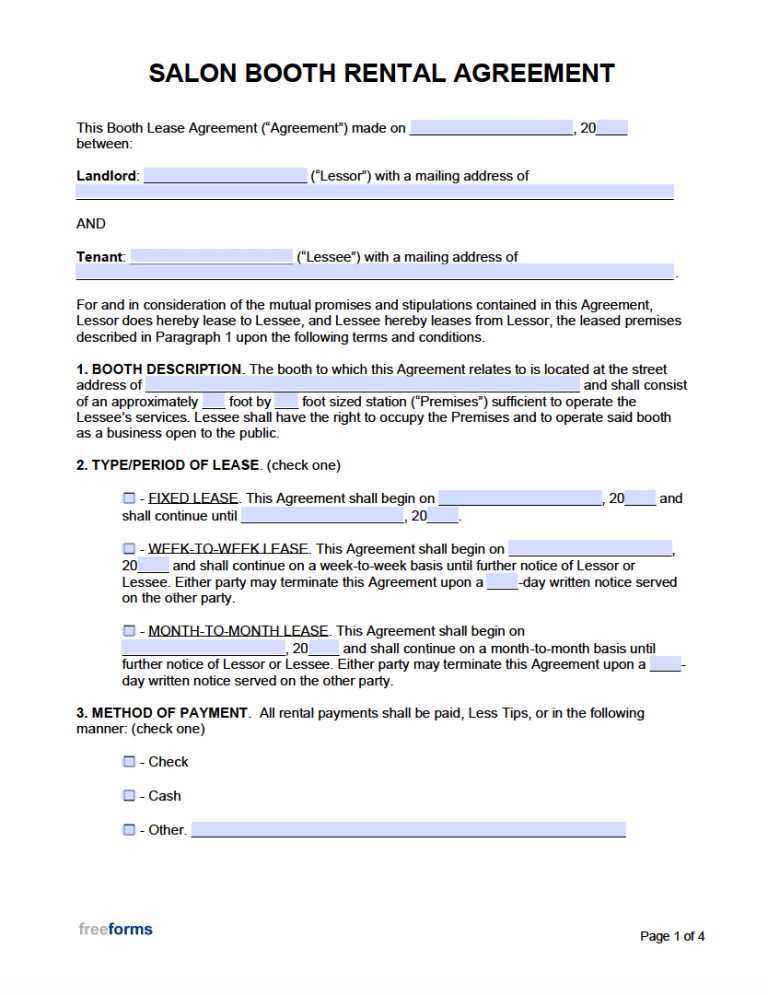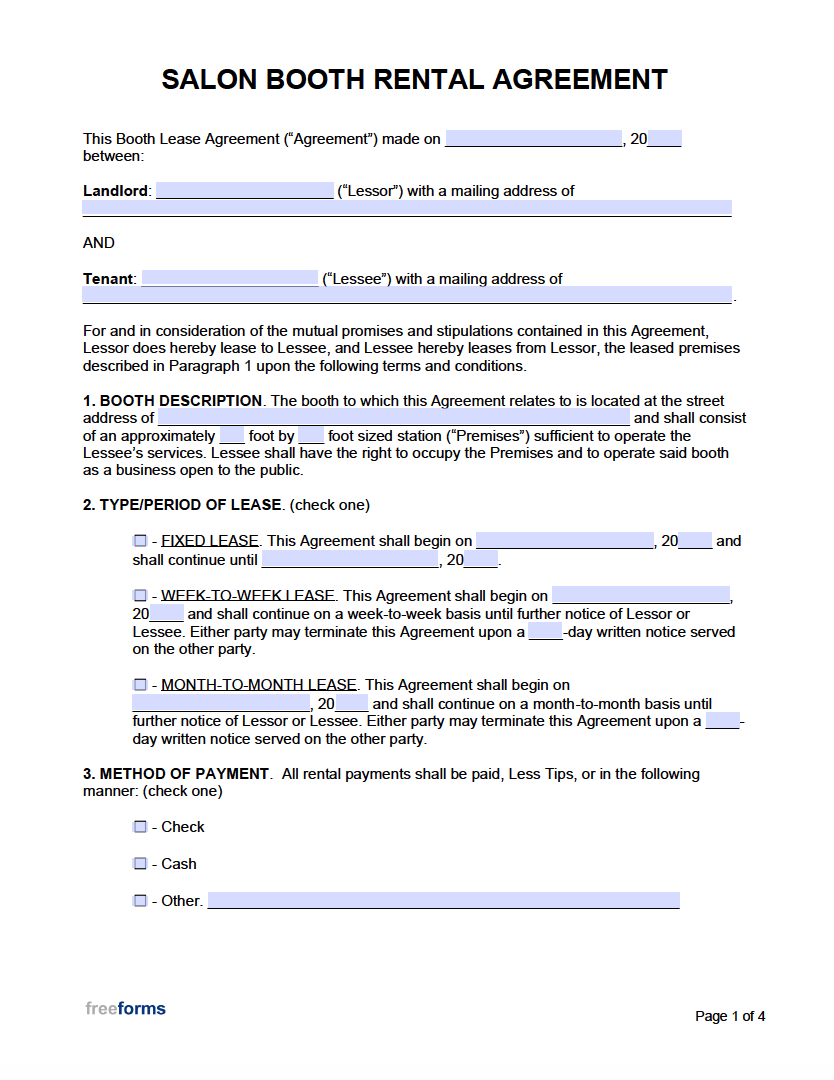What is a Salon Booth Rental Agreement?
A designated form formalizes the obligations of the involved parties. The following information will be required to formulate the terms and solidify the understanding:
- Lessor Name (Renting Owner)
- Lessee Name (Renting Tenant)
- Property Address
- Booth Area Description
- Lease Length Duration
- Lease Type (Fixed/Percentage)
- Rental Payment Schedule
- Allocated Equipment Use
- Premises Use
- Property Tax Responsibility
- State Law Provisions Governing Booth Rental
- Corroborating Signatures from the Lessor and Lessee
- Date of Signature
How to Use a Salon Booth Rental Agreement
The certified transcript allows the participating parties to document the transaction to uphold the commitments with an accurate record of the promises made. The booth rental paperwork determines the numerous specifics to be adhered to for the term. The document states the rental payment amount and procedure for payment remittance on a fixed, monthly, or weekly basis. The leasing period is defined, along with the type of rental arrangement, citing a commitment to a fixed rate. The rental agreement also includes a provision to indicate if there is an additional percentage rent due based on the income earned on-site by the tenant.
A thorough description of the assigned space and contributed equipment is contained in the leasing composition. The contract additionally maps out a framework for policies and practices to be followed to maintain a safe and comfortable working environment. Elements of the document outline clauses about utilities distribution, and any property taxes for which the tenant will be responsible. Subletting of the booth may apply to the case should it be indicated in the rental agreement.
How to Rent a Salon Booth
When leasing the use of a section in a hair salon, the contract forms a relationship between the owner of the salon and a stylist working as an independent contractor. When selecting an individual to operate within the space, they will essentially represent the salon. For this reason, it is important to screen potential lessees to ensure that they can meet the necessary expectations to protect the reputation of the salon. Because there is not a traditional employee-employer relationship applied to the situation, both parties will be held to the agreement, which must state the promises maintained during the term of rental. There is, therefore, no granted option for the owner to fire a hairstylist based on poor performance, so indicating the expected quality of work in writing is necessary for a suitable work environment.
Step 1 – Attracting Hairstylists to Rent a Booth
When seeking out potential stylists to join the business, it is vital first to establish the salon’s brand and target market to draw in prospective talent that will harmonize with the current atmosphere. Listing desired particulars regarding the desired expertise and skill set will allow for the possibility of progression for both the stylist and the salon. Creating posts on multiple job sites can aid in search of potential booth renters and help in the screening process as well. Some reputable job listing sites to utilize are:
Additional sources for finding a stylist could be to recruit at hair shows or by word of mouth within the professional community. Keep in mind that scouting at cosmetology schools for newly licensed hair professionals may not be ideal, as those new to the field may not be equipped with the experience or clientele base to afford this particular option of employment. Signing those experienced individuals in the field will ensure a safer bet in avoiding turnover.
Step 2 – Performing an Interview to Ensure Expertise and Compatibility
When considering an individual to rent a booth within a salon, it is essential to thoroughly examine the applicants’ work history, credentials, and special skills. When conducting an interview, it is customary for the possible booth tenant to come prepared for the interview with a presentable resume, evidence of education, and any advanced certification for additional expertise. Presenting organized evidence of a current client list can additionally provide peace of mind to a lessor. It is also essential to examine whether or not the stylist would be a good fit for the particular salon that is renting the space. Having an in-depth conversation to cover the full range of the proposed work and environment will ensure a better chance for success.
Step 3 – Running Required Background Examination
It is common practice for an employer to run a customary background check to ensure the eligibility of those hired. Although booth rental does not establish a typical employer-employee relationship, it is suggested to investigate the background of a tenant to protect the respectability of the business. Requesting the possible renter to submit a filled background check authorization form will essentially release the right of the salon to review the applicant’s credentials to evaluate the acceptability of the individual to rent the space. Once the form is completed and signed, permission is granted to perform the evaluation. The indexed sources below can aid in the background investigation:
- AccurateNow (starting at $24.95)
- GoodHire (starting at $29.99)
- Backgroundchecks.com (starting at $29.99)
- B&B Reporting (starting at $38.95)
- HireRight (starting at $39.95)
Step 4 – Confirming License Qualifications
A cosmetology license is compulsory within all fifty states to receive compensation for cutting hair and all related services within the industry. An index of those qualified with an active license is made available for research purposes.
Licensed Hair Stylist Lookup – By State
- Alabama
- Alaska
- Arizona
- Arkansas
- California
- Colorado
- Connecticut
- Delaware
- Florida
- Georgia
- Hawaii
- Idaho
- Illinois
- Indiana
- Iowa
- Kansas
- Kentucky
- Louisiana
- Maine
- Maryland
- Massachusetts
- Michigan
- Minnesota
- Mississippi
- Missouri
- Montana
- Nebraska
- Nevada
- New Hampshire
- New Jersey
- New Mexico
- New York
- North Carolina
- North Dakota
- Ohio
- Oklahoma
- Oregon
- Pennsylvania
- Rhode Island
- South Carolina
- South Dakota
- Tennessee
- Texas
- Utah
- Vermont
- Virginia
- Washington
- West Virginia
- Wisconsin
- Wyoming
Step 5 – Brokering the Terms of the Leasing Contract
Modifications to the downloadable agreement can be made based on the needs of both the salon owner and the hairstylist. Designation of payment technicalities regarding the monthly payments and percentage of earnings options can be discussed to find a mutual understanding. Those individuals that can provide specialized services or a catalog numerous clients may have more leverage in arranging a lower rate because of the value they can offer to a salon. The supplying of equipment to a lessee should also be specified should it be necessary to perform the appropriate services.
Step 6 – Finalizing the Contract
When the paperwork is thoroughly filled and agreed to by all involved parties, the execution of the document can take place. Once the owner and independent renter have endorsed and dated the form, the first payment installment will be due to the owner as detailed in the accord. After the initial payment is made, utilization of the space can then occur, and the licensed professional can manage the providing of services to their clients in the salon.

